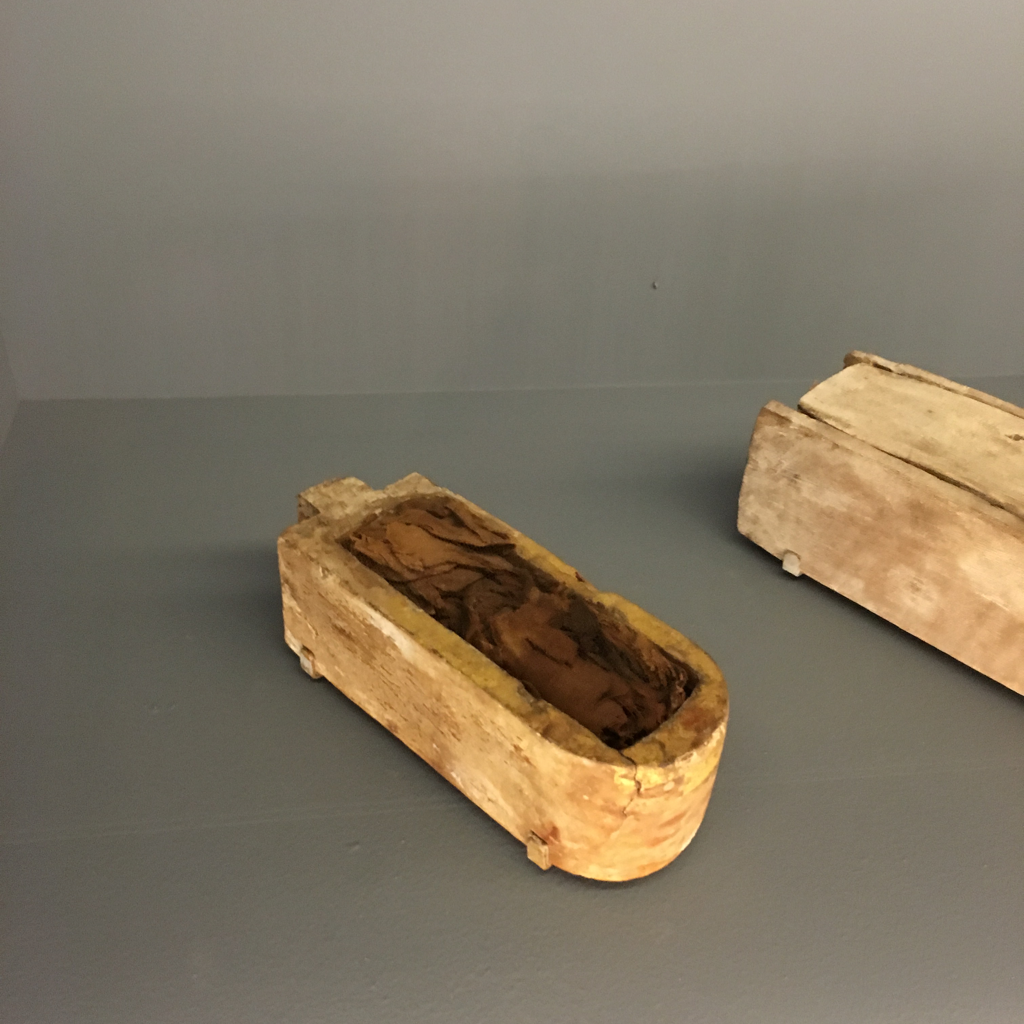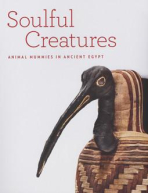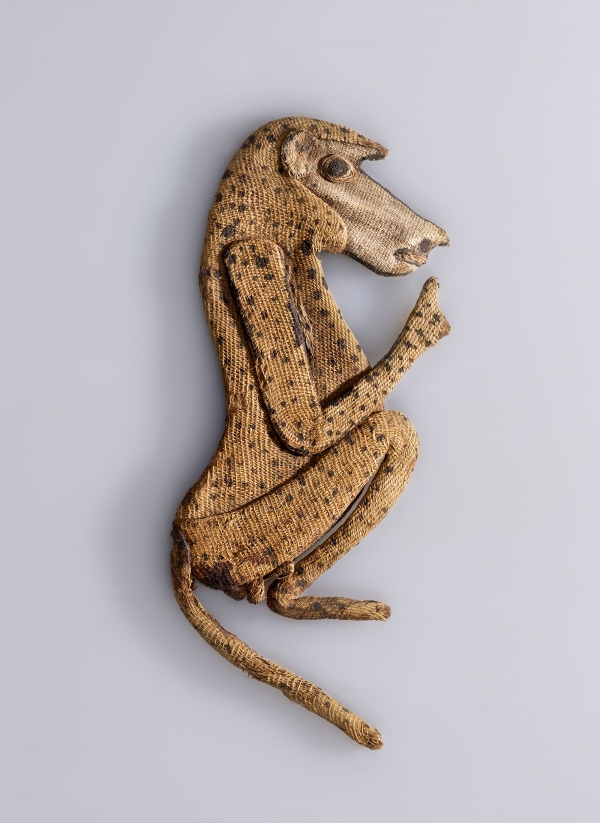
Baboon Appliqué from an Animal Mummy. Possibly from Saqqara, Egypt. Ptolemaic Period, 305–30 B.C.E. Linen, 51/2 x 23/8 in. (14.2 x 5.6 cm). Brooklyn Museum; Charles Edwin Wilbour Fund, 37.272E. (Photo: Gavin Ashworth, Brooklyn Museum)

Baboon Appliqué from an Animal Mummy. Possibly from Saqqara, Egypt. Ptolemaic Period, 305–30 B.C.E. Linen, 51/2 x 23/8 in. (14.2 x 5.6 cm). Brooklyn Museum; Charles Edwin Wilbour Fund, 37.272E. (Photo: Gavin Ashworth, Brooklyn Museum)
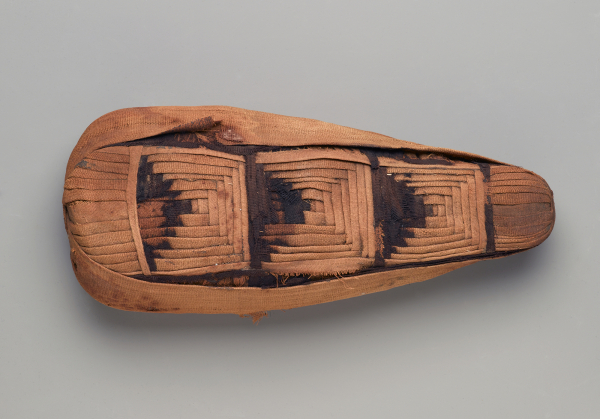
Ibis Mummy. From Egypt. Late Period to Ptolemaic Period, Dynasty 27 or later, 400–110 B.C.E. Animal remains, linen, paint, 43/4 x 215/16 x 105/8 in. (12.1 x 7.5 x 27.0 cm). Brooklyn Museum; Brooklyn Museum Collection, X1179.4. (Photo: Sarah DeSantis, Brooklyn Museum)
Egyptians of the first millennium B.C.E. believed that they could appeal to the god Thoth to intercede in human affairs. Ibis mummies allowed such a petitioner to send a message to the god.
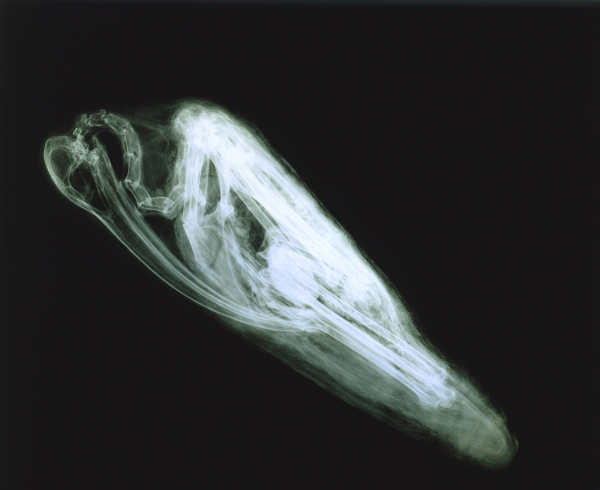
X-ray of Ibis Mummy (Brooklyn Museum, 14.651)
The CT scan shown here reveals that the wrappings of this mummy directly reflect the position of the ibis’s bones and its beak, curving over its breast. The length of the beak indicates a male.
Carbon 14 dating of a sample taken from the linen places this mummy in a period earlier than suggested by the wrapping style. Future testing will include in addition a sample from the animal itself, to determine whether old, recycled linen was used in preparing the mummy.
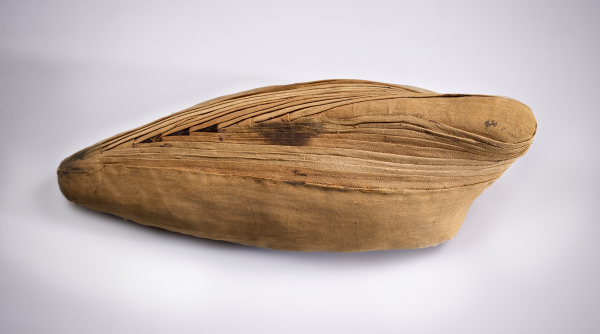
Ibis Mummy. From the ibis cemetery at Abydos, Egypt; excavated by the Egypt Exploration Fund. Late Period to Ptolemaic Period, 410–200 B.C.E. Animal remains, linen, 55/16 x 51/2 x 159/16 in. (13.5 x 14 x 39.5 cm). Brooklyn Museum; Gift of the Egypt Exploration Fund, 14.651. (Photo: Gavin Ashworth, Brooklyn Museum)
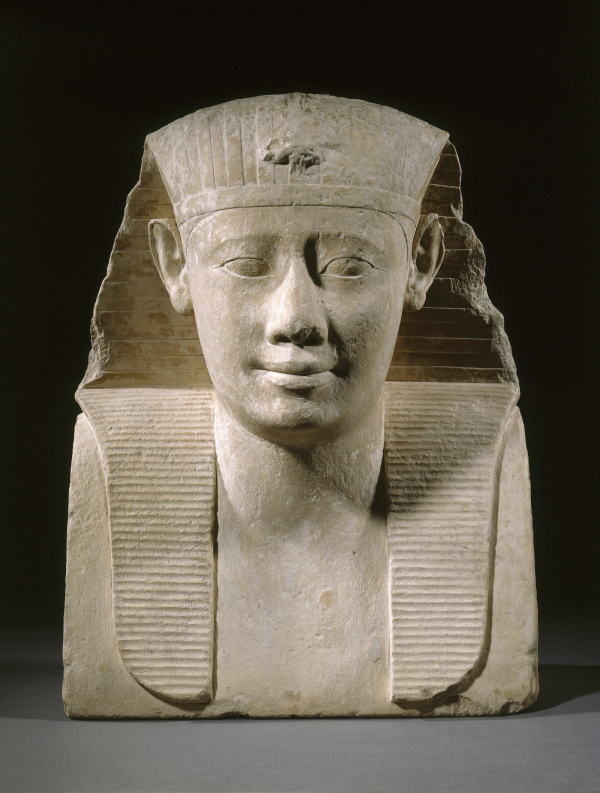
King Ptolemy II. Reportedly from Benha il-Assel, Egypt. Ptolemaic Period, reign of Ptolemy II, 285–246 B.C.E. Limestone, 171/2 x 133/4 x 71/2 in. (44.5 x 34.9 x 19.1 cm). Brooklyn Museum; Charles Edwin Wilbour Fund, 37.37E. (Photo: Brooklyn Museum)
The Ptolemies, a family of Greek-speaking kings who ruled Egypt after Alexander’s death, supported and encouraged Egyptian religion, including the practice of making animal mummies. Royal regulations ensuring the honest manufacture of animal mummies were written and enforced by these kings.
Here, Ptolemy II is portrayed as an Egyptian king wearing the nemes-headcloth. Though they themselves were ethnic Greeks, the Ptolemies adopted Egyptian culture.

Horus Falcon-Form Coffin. From Egypt. Late Period to Ptolemaic Period, circa 664–30 B.C.E. Bronze, gold, 115/16 x 25/8 x 83/16 in. (28.8 x 6.6 x 20.8 cm). Brooklyn Museum; Charles Edwin Wilbour Fund, 05.394. (Photo: Gavin Ashworth, Brooklyn Museum)
The god Horus was the son of the first king and queen, Osiris and Isis. Thus, in human form, he is often worshipped as a child. But Horus was strongly associated with the falcon and, as a sky god, with the sun. Images of Horus as a child are often found in falcon mummy cemeteries mixed together with falcon-shaped mummy coffins, as if they have similar votive functions.
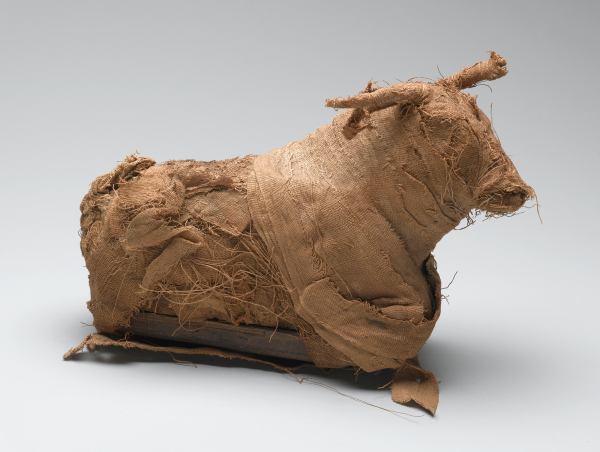
Model of a Bull. From Egypt. Third Intermediate Period or Late Period, Dynasty 21‒30, circa 1075–332 B.C.E. Reeds, cloth, 511/16 x 27/8 x 97/16 in. (14.5 x 7.3 x 24 cm). Brooklyn Museum; Charles Edwin Wilbour Fund, 37.1381E. (Photo: Sarah DeSantis, Brooklyn Museum)
This linen model of a bull encloses a single bone, perhaps bovine. Votive mummies could contain only part of the animal. Often, elaborate wrappings seem to substitute for the animal itself.

Pepy I with Horus Falcon. From Upper Egypt. Old Kingdom, Dynasty 6, reign of Pepy I, circa 2338–2298 B.C.E. Egyptian alabaster, 107/16 in. (26.5 cm) high. Brooklyn Museum; Charles Edwin Wilbour Fund, 39.120. (Photo: Brooklyn Museum)
King Pepy I sits on his throne wearing the tall white crown of Upper Egypt and an enveloping cloak associated with the Jubilee, a festival that demonstrated the king’s continued vigor after the first thirty years of his reign (though it was sometimes celebrated earlier).
Some scholars have suggested that the Egyptians created votive animal mummies to use in this festival.
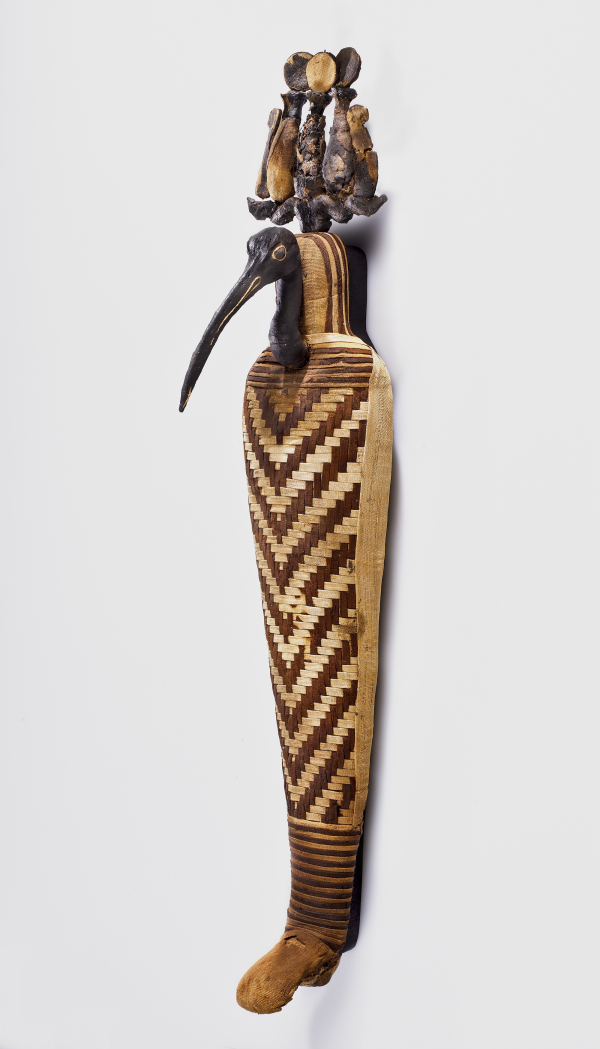
Ibis Mummy. From the ibis cemetery at Abydos, Egypt; excavated by the Egypt Exploration Fund. Early Roman Period, 30 B.C.E.–early 1st century C.E. Animal remains, resin, linen, 413/16 x 255/16 in. (12.3 x 74.5 cm). Brooklyn Museum; Gift of the Egyptian Exploration Fund, 14.655. (Photo: Gavin Ashworth, Brooklyn Museum)
Often, the more elaborate the wrapping, the less likely it is that the whole animal is inside, as the two CT scans shown here reveal. Perhaps the intricate wrapping substitutes for the animal.
This ibis is the most elaborately wrapped of all the animal mummies on display here. The herringbone pattern linen, the beak, and the elaborate crown all cover a mummy made only from ibis feathers. In contrast, the simple circular wrapping of this cat, with a head modeled in linen, conceals a complete cat mummy.

Dog Mummy. From Egypt. Late Period to Ptolemaic Period, 510–230 B.C.E. Animal remains, linen, 31/4 x 17 x 51/2 in. (8.3 x 43.2 x 14 cm). Brooklyn Museum; Charles Edwin Wilbour Fund, 37.1984E. (Photo: Christine Gant, Brooklyn Museum)
Scholars associate the coffered, box-like pattern of linen wrapping on this dog mummy with the Roman Period in Egypt (30 B.C.E.–395 C.E.). Yet carbon 14 dating of a linen sample from this mummy suggests the linen is at least two hundred years older than that period. Either very old linen was recycled in the process of mummy making or this distinctive pattern of wrapping existed earlier than scholars had suspected. Future tests might resolve this question by sampling and testing the animal itself.

Crocodile Stela. From Dahamsha, Egypt. New Kingdom, Dynasty 19‒20, circa 1292–1075 B.C.E. Limestone, 61/2 x 911/16 x 25/8 in. (16.5 x 24.6 x 6.7 cm). Brooklyn Museum; Charles Edwin Wilbour Fund, 67.174. (Photo: Brooklyn Museum)
The Egyptians harnessed the powers of a ferocious animal to ward off danger. In marshy areas inhabited by crocodiles, people living nearby identified this animal with their town god. Here, the divine crocodile is on a shrine with an offering table in front of him.
This fragment of a stela (commemorative stone slab) originally illustrated a prayer invoking the crocodile god Sobek, who provided all that the deceased needed in the next world.
Soulful Creatures: Animal Mummies in Ancient Egypt
September 29, 2017–January 21, 2018
In the ancient burial ground at Saqqara, Egypt, one animal cemetery alone has yielded over four million individual ibis mummies. And the nearby dog cemetery contained over seven million mummies, with countless others found throughout Egypt. This unusual aspect of ancient Egyptian culture and religion—the mummification of animals—has remained largely a mystery. Soulful Creatures: Animal Mummies in Ancient Egypt explores the religious purpose of these mummies, how they were made, and why there are so many.
Drawn from our renowned collection, the exhibition features choice examples from among the many millions of mummies of birds, cats, dogs, snakes, and other animals preserved from at least thirty-one different cemeteries throughout Egypt. Animals were central to the ancient Egyptian worldview. Most animals had connections to a particular deity. After death, mummified animals’ souls could carry a message to a god.
Yet not all animal mummies are what they seem. Scientific investigation of the mummies reveals that the corruption in the animal cemeteries that some contemporaneous texts allege was all too real. CT scans displayed in the exhibition uncover the empty wrappings, double mummies, and misleading packaging among some of the mummies that the priests sold to worshippers.
Soulful Creatures: Animal Mummies in Ancient Egypt is organized by Edward Bleiberg, Senior Curator of Egyptian Art, and Yekaterina Barbash, Associate Curator of Egyptian Art, Brooklyn Museum. The accompanying book is published by the Brooklyn Museum in association with D. Giles Ltd, London.


